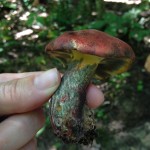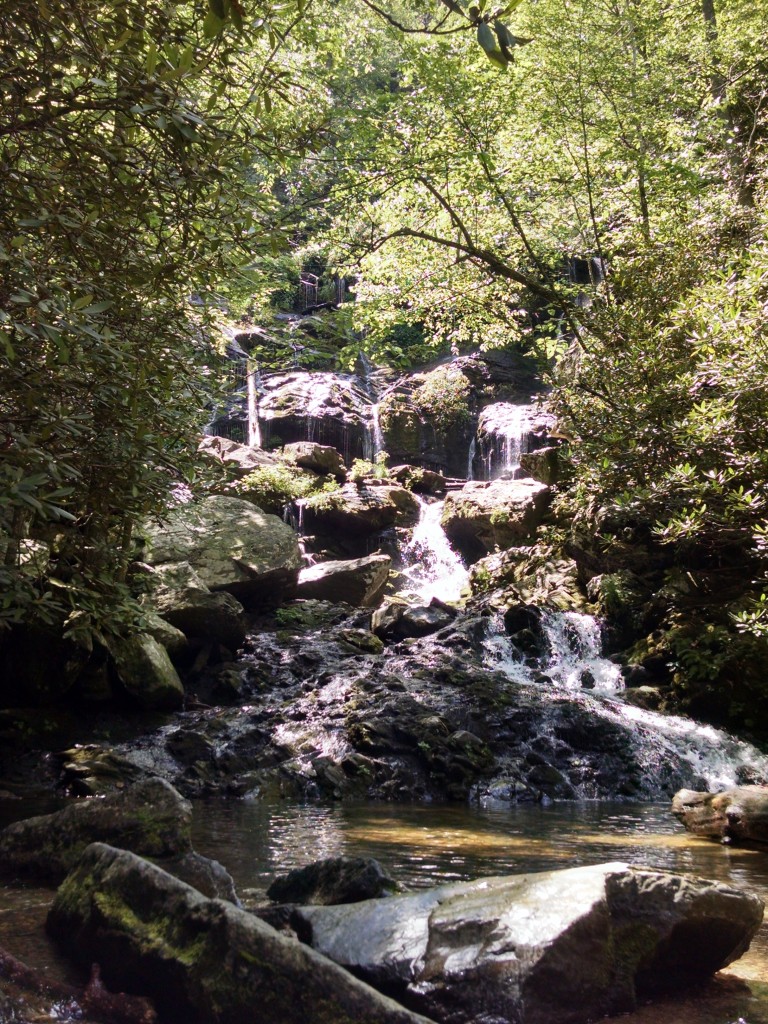Written by Elizabeth Drisko
On a sunny morning on August 17, 2016, a group of 15 students from the Blue Ridge School of Herbal Medicine met at the Catawba Falls parking lot for a plant and mushroom walk with Marc Williams. He recommended various texts to folks interested in vascular plants, including Guide to Vascular Plants of the Blue Ridge by B. Eugene Wofford, Peterson’s Guide to Trees & Shrubs, and A Field Guide to the Trees and Shrubs of the Southern Appalachians by Robert Swanson. After a discussion of favorite trees, the group began the walk in high spirits. The specific focus of the day was trees and shrubs, but Marc could not help but introduce mushrooms that popped up on the path. A total of 25 different plants and mushrooms were identified, here listed by family or scientific name, and discussed.
We first came across three trees which resembled each other, a yew (Taxus sp.), hemlock (Tsuga canadensis), and Virginia Pine (Pinus virginiana). Hemlock, spruce, and fir from the Pinaceae, yew Taxaceae, and cypress (Cupressaceae) all produce needles and are evergreen. The yew family (Taxaceae) has spirally arranged needles that are relatively short and simple in construction.
and has a unique female cone with one seed called an aril. The red flesh on the outside is edible but the seed is poison to humans. Yew is considered an anti-cancer taxol. Hemlock (Pinaceae) has white lines on underside of needles and has longer, single needles. Hemlock needles contain vitamin c and are used for dye, and reishi (Ganoderma tsugae) grows on fallen hemlocks. Virginia Pine (Pinus virginiana) needles are arranged in cluster of two,

making a V shape. If a plant is in the pine family but is not a pine, then the needles show up singly.
After examining a slippery elm (Ulmus rubra) which sticks to your hands with rough hairs on both sides, has a prominent drip tip, and the elm characteristic of prominent veins, we saw a bolete (Boletaceae) mushroom.

It was stemmed with pores, and when you touch the yellow pores, they turn blue. Only a few boletes out of hundreds are known to be very poisonous to adults, but a quite a few can make you very uncomfortable. Leaving out the ones that have red or orange/yellow pores and stain blue and that are not bitter will at least provide some survival food if necessary.

We passed the day in such a way, next coming across a paw paw (Asimina triloba) tree. Paw paws have the largest fruit in the United States and are called colloquially ‘Hoosier bananas’ in Indiana. The tree clones but is not self-fertile, so a patch of paw paws may not have fruit unless flies or beetles have fertilized them from a separate tree. The patch we came across was fruiting! Paw paws resemble another ancient flower plant the magnolias (Magnoliaceae) with their big leaves and flowers in parts of 3s.
We also saw cinnabar chanterelles (Cantharellus cinnabarinus) and another type of chanterelle (Cantharellaceae), leatherback (Lactarius sp.) milk mushrooms (Russulaceae), magnolia (Magnolia fraseri), Mockernut and Pignut hickory (Carya tomentosa, C. glabra), black locust (Robinia pseudoacacia), basswood (Tilia sp.), an amanita variety that could possibly dissolve your liver (Amanitaceae), grapevines (Vitis sp.), coral fungi (Clavariaceae), ash (Fraxinus sp.), Northern Red and White oaks (Quercus rubra and Q. alba), hawthorn (Crataegus sp.), sochane (Rudbeckia laciniata), and mimosa (Albizia julibrissin).
A favorite waterfall of waterfall hunters in the area, the beautiful cascades of Catawba Falls were refreshing after a hot climb and some students opted for a dunk. Picnicking, swimming, and exploration of the area provided more good times. By then clouds were rolling in and thunder was sounding, but we made it back more dry than not.
And by the way, what did the anther say to the pistil that he had a crush on?
Girl, I really like your style.
Thanks for that, Marc!

